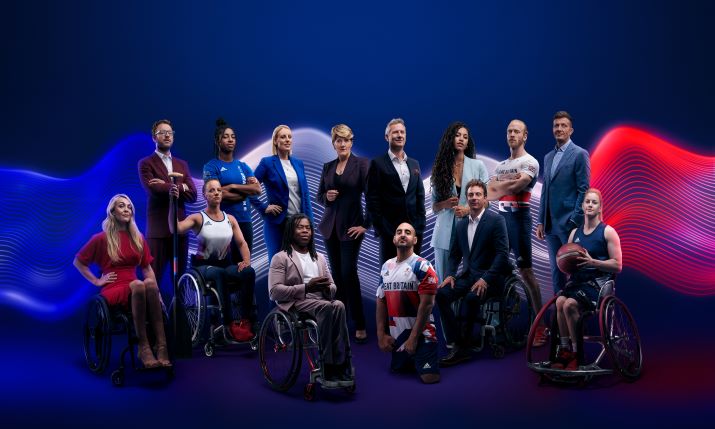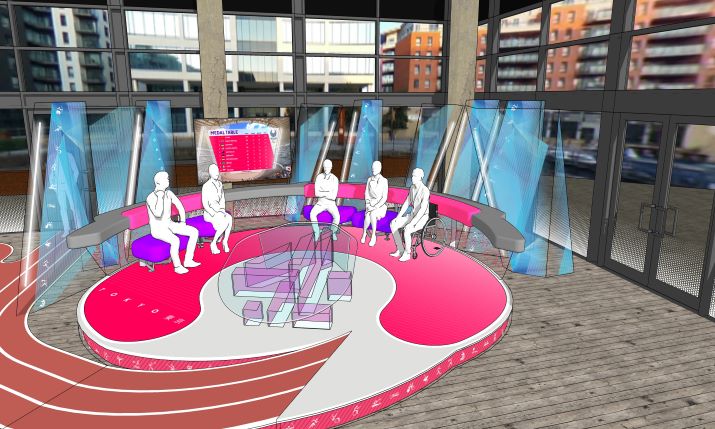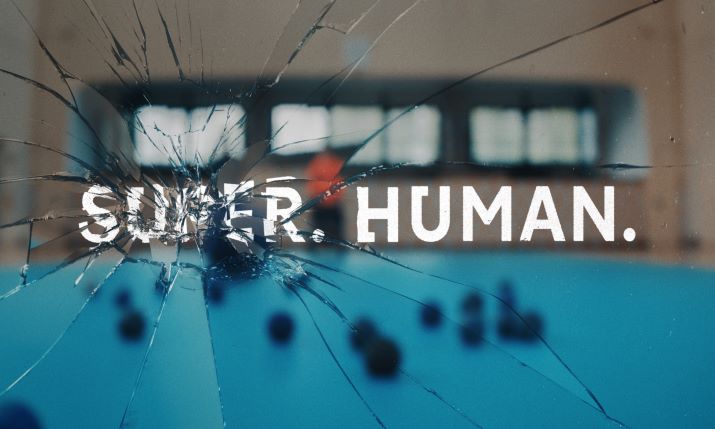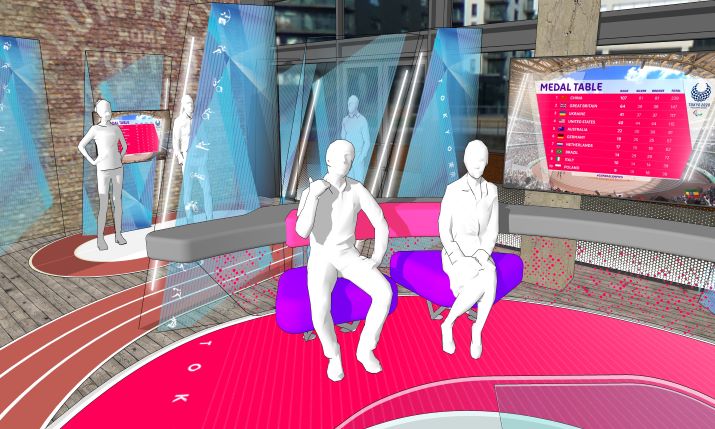Tokyo, Leeds, London: Channel 4 outlines the grand plan for its most in-depth Paralympic coverage yet

Channel 4’s Paralympics presenters and key athletes are ready for the Games to begin
UK broadcaster Channel 4 is planning its most ambitious ever Paralympic Games coverage for Tokyo 2020, including a hugely representative team of on-screen talent as well as a new microsite that will allow fans to view over 1,000 hours of sports coverage over 16 live streams, on top of its linear offering that will total over 300 hours.
Pete Andrews, head of sport at Channel 4, tells SVG Europe: “We’re taking direct feeds from OBS for our Paralympics microsite, so every sport will be live on there. That’s up to 16 streams, with host broadcast commentary, and 500 to 600 hours of it will be subtitled.”
That is an achievement that Andrews is excited about. He says: “That’s never been done before for Paralympic sport. I mean, it’s off the scale, you know, you can sit for 16 and a half hours to watch purely Paralympic coverage on Channel 4, and we’ve never had More4 going at the same time, with the team sport channel.
“We’ve been really building up the Paralympics with quite ambitious stuff that runs in peak time on Channel 4. And that is about sport, but also about life and society and just putting these people front and centre, so we’re really excited about that as well”
“So [this Paralympics for Channel 4 is] much bigger in hours. It’s much bigger in content. It’s much bigger in domination of the channel, digitally and socially, plus there’s specific social programmes going out. Because of the time zone, we’ve got to really push everything we can because of course, with the best will in the world, people don’t always stay up till 4am to watch live sports, whatever it may be.”
He continues: “[The microsite is] a separate offering [from the linear TV channels. So if you’re just interested in equestrian or if you just want to watch the rowing, you go to the microsite and every sport [is there]. Otherwise, we’re obviously doing two channels for full production; Channel 4 which is all through the night [with a] breakfast show at 7.30am, rejoining live coverage at 9am, all the way through to 2.30pm. We’ll obviously be cherry picking, you know, trying to get gold medal moments there.
“And at the same time, More4 comes on at 7.30am, and More4 is going to do team sports like wheelchair basketball, wheelchair rugby, and sitting volleyball and things like that, [so that people can] get to watch the whole game; it’s not exclusively team sport, of course, because if something else happens… but More4 is going to be team sport [predominantly].”

Channel 4 has designed a studio at its headquarters in Leeds, UK, from which it will host a party-style Paralympic show
Making huge strides
Channel 4 is pushing its offering harder than ever for Tokyo, which is being produced by Whisper. Andrews states: “We’ve made huge strides in where we’re putting the pre-Para content, to then signpost to a Paralympics which is more difficult to absorb the whole thing because it is [happening] overnight. We’re really doing everything we can to make it as big as possible. It’s bigger than ever before, and we’re doing everything we can [to reach high viewing figures]. The tone and the reach is really important, and what we need to do is make sure we reach as many people [as possible], despite the fact it’s not as easy [this year].”
“Initially we would have had a studio with an audience in Tokyo, so it was always an idea to bring people together and watch together, so we had to transport that to the UK. It never seemed like a good option to go to Tokyo and then put up virtual studio, because then why are you in Tokyo?”
In the build up to the Paralympics Channel 4 has ramped up its pre-event content coverage, which it is running in primetime slots to pull viewers in and to hopefully counterbalance the time difference issue. “We’ve been really building up the Paralympics with quite ambitious stuff that runs in peak time on Channel 4. And that is about sport, but also about life and society and just putting these people front and centre, so we’re really excited about that as well.”
4Studio, Channel 4’s new digital arm that launched in June 2020, as well as LiveWire Sport, which held the original digital content contract with the broadcaster for the Games, are managing all social media, “so we’ve got double the effort on that stage; so those guys are working together to make digital propositions to reach as many people as possible,” says Andrews, who adds: “We really are driving hard in every direction because we know we need to get out there and bring people to the Paralympics.”

Channel 4’s Paralympics campaign was kicked off by an edgy campaign, Super. Human
Representative talent
The broadcaster has also announced a first for the Paralympics; that 70% of its Paralympics on-screen talent is disabled, marking the largest number of disabled presenters ever seen on UK television. Notes Andrews: “We’ve got to keep that pathway running. The challenge then is to keep these guys in television and presenting on television and getting jobs [in other areas] other than disabled sport.”
Channel 4 will run a one hour highlights programme, Paralympics Today, from 5pm each day. This will be pre-recorded in Tokyo and hosted by Ade Adepitan. Notes Andrews: “Because of the time [difference between Japan and the UK] it will be pre-recorded. It puts together a really high production value trip around Tokyo [into a] highlights programme. The feeling is that we can give a real look around the city, which we’ll be missing a little bit from the live because of all the restrictions [in place in Japan right now].
“Then at 7.30pm we have the Paralympics Gold Rush, [presented from Leeds, hosted by Clare Balding] which is all the best bits of the day following the news, then The Last Leg’s on at 10pm to 11pm [live from London, hosted by Adam Hills, Alex Brooker and Josh Widdicombe, plus Rosie Jones in Tokyo], and then we’re going to repeat the [highlights programme] from 11pm.”
Spoken word over graphics
In a move unlike most other broadcasters in their sports coverage strategies today, Channel 4 is staying away from graphics and augmented reality (AR). It will not be using para sport graphics educator, Lexi Global, this year, which it last used at Rio 2016, to graphically illustrate levels of physical ability for the Paralympic classifications for viewers. Instead it is, “using the athletes to explain their disabilities and to explain their own disciplines,” states Andrews.
He explains the logic behind Channel 4’s decision: “I think it felt that [a verbal explanation] adds a bit of extra context. Signposting of the sport is hugely important and there’s a tendency [at Channel 4] to try not to rely on a graphic where we can actually explain to everyone what’s happening. I think we just feel like we’ve evolved into a more detailed explanation. So the commentators will be armed with explanations and wording on how to explain the disciplines and there will be VTs explaining the degree [of ability] by the athletes themselves. We’ve evolved into giving a bit more ownership of the categories to the Paralympians themselves.”
This move to verbal explanations takes Channel 4 in a different direction to most other broadcasters, who are using ever-more AR, virtual studios and advanced graphics to provide viewers with detail.
Andrews comments on this point: “I know exactly what you mean. We’ve just seen the Euros go through with both the BBC and ITV using big AR studios, and we don’t have an AR studio; we have a physical studio with a physical set and we have people physically in the stadiums, and I think that is a point of difference for Channel 4.”
He goes on: “I guess we were always wanting to try and give people the feeling of being there, and that’s why we’ve held onto these positions, you know, although they’re difficult – swimming and the athletics – but we really want to transport people. Our idea is to try and create some of the atmosphere that will be [absent] without a full stadium in Tokyo; we want our studio to be a real party and celebrate the atmosphere. So that’s why we’re sort of prioritising having the friends and family who can’t travel [in the studio], and the fans can’t travel. We want to build the atmosphere, and I think if you’re going to do that, an AR graphic studio is sort of the opposite; what you need is just a space to get everybody together.”
Andrews adds that the plan had been to host the studio in Tokyo rather than Leeds, but COVID has forced the change. “Initially we would have had a studio with an audience in Tokyo, so it was always an idea to bring people together and watch together, so we had to transport that to the UK. It never seemed like a good option to go to Tokyo and then put up virtual studio, because then why are you in Tokyo? And interestingly [now], knowing that none of the friends and families [of the Paralympians can] go [to Japan], it then became even more important. Now COVID could still ruin that, but we would love to have everyone together, celebrate it and just have a party in Leeds.
“It doesn’t mean we wouldn’t do AR another time, but AR just doesn’t fit that idea,” he notes.

“It never seemed like a good option to go to Tokyo and then put up virtual studio, because then why are you in Tokyo? And interestingly [now], knowing that none of the friends and families [of the Paralympians can] go [to Japan], it then became even more important. Now COVID could still ruin that, but we would love to have everyone together, celebrate it and just have a party in Leeds,” Pete Andrews, head of sport at Channel 4, tells SVG Europe
Channel 4 is using multiple locations to produce its broadcast, explains Andrews: “We’re sending 74 people to Japan in total. It would have been a lot more; the original plan pre-COVID was to host – and I’m sure the BBC were the same – the whole thing from Japan. We’re obviously quite a long way away from that now, but we’re sending 74 people; technicals, some presenters and interviewers, and camera crews as well. But it’s essentially now working across three different hubs for us, so we’ve got the IBC in Japan and feeds from all the venues. We’ve still got the presentation areas at the athletics and the swimming and the cycling, and then our main hub is in Ealing, and our studio is in Leeds at our national headquarters, so we’re using the Steph’s Packed Lunch studio; we’re re-purposing that studio for the Paralympics and we’re hoping to get an audience in.”
However, he adds: “Everything has a COVID threat. The idea is obviously to get an audience in there; we’re looking to get friends and families of Paralympians, coaches and local schools, all in to join what we’re calling the Paralympics party in Leeds, but the backend will be in Ealing. So it will be the live coverage from Japan, and it will come to Ealing where the gallery for our studio space in Leeds will be. So it’s a bit of a triangle of how we get to make it work.”
He adds: “OBS has been brilliant. They’ve been so helpful [especially] if you consider how many things we’ve had to cancel or change, and they’ve been really patient. Everything’s so fluid; we’re really grateful to OBS. I mean, their coverage of things like rowing and canoeing is better than ever before, you know, all really high spec. There’s only a few sports that aren’t covered live. Obviously we’d love everything covered live, but we’re also really grateful for the brilliant job [they’re doing].”
Andrews concludes: “The last Paralympic team was confirmed [Wednesday 21 July], so we didn’t even know what athletes were going. So everything with the Paralympics is this is quite late because of COVID, so we’re still filling in the names on the sheet. It has been a really complicated plan.”
The Tokyo 2020 Paralympic Games will feature 539 events across 22 sports hosted at 21 venues. It runs from 24 August until 5 September.

